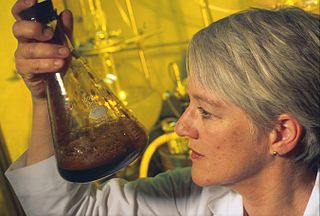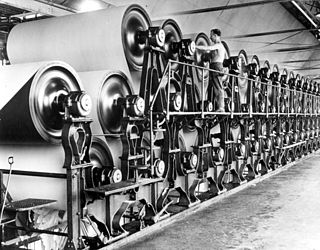 W
WThe pulp and paper industry comprises companies that use wood as raw material and produce pulp, paper, paperboard and other cellulose-based products.
 W
WIn industrial chemistry, black liquor is the by-product from the kraft process when digesting pulpwood into paper pulp removing lignin, hemicelluloses and other extractives from the wood to free the cellulose fibers.
 W
WFrantišek Bohdal was a Czechoslovak worker in the pulp and paper industry, holder of Czechoslovak state decorations and local politician.
 W
WThe conical refiner is a machine used in the refining of pulp in the papermaking process. It may also be referred to as a Jordan refiner, after the American inventor Joseph Jordan who patented the device in 1858.
 W
WPulp is a lignocellulosic fibrous material prepared by chemically or mechanically separating cellulose fibers from wood, fiber crops, waste paper, or rags. Mixed with water and other chemical or plant-based additives, pulp is the major raw material used in papermaking and the industrial production of other paper products.
 W
WHenry Fourdrinier was a British paper-making entrepreneur.
 W
WSealy Fourdrinier was an English paper-making entrepreneur.
 W
WA Hollander beater is a machine developed by the Dutch in 1680 to produce paper pulp from cellulose containing plant fibers. It replaced stamp mills for preparing pulp because the Hollander could produce in one day the same quantity of pulp it would take a stamp mill eight days to prepare.
 W
WThe Holyoke Testing Flume was a hydraulic testing laboratory and apparatus in Holyoke, Massachusetts, operated by the Holyoke Water Power Company from 1870 to 1932, and used to test the performance of water turbine designs, completing 3,176 tests of efficiency in that time. It was described by Robert E. Horton in court testimony as the only facility of its kind in the 19th and early 20th century, which made possible the standardization of American water turbines. Indeed Clemens Herschel, who managed and redesigned the facility in the 1880s, later described it in Congressional testimony as the "first modern hydraulic laboratory" in the United States and the world. It was through Herschel's need to determine the water power consumption of different mills, and in this testing system that he would invent the Venturi meter, the first accurate means of measuring large-scale flows, which still retains widespread use in modern technology today.
 W
WCarl Kellner was a chemist, inventor, and industrialist. He made significant improvements to the sulfite process and was co-inventor of the Castner-Kellner process. He was a student of Freemasonry, Rosicrucianism, and Eastern mysticism. He was the putative founder of Ordo Templi Orientis.
 W
WThe kraft process (also known as kraft pulping or sulfate process) is a process for conversion of wood into wood pulp, which consists of almost pure cellulose fibers, the main component of paper. The kraft process entails treatment of wood chips with a hot mixture of water, sodium hydroxide (NaOH), and sodium sulfide (Na2S), known as white liquor, that breaks the bonds that link lignin, hemicellulose, and cellulose. The technology entails several steps, both mechanical and chemical. It is the dominant method for producing paper. In some situations, the process has been controversial because kraft plants can release odorous products and in some situations produce substantial liquid wastes.
 W
WPaper engineering is a branch of engineering that deals with the usage of physical science and life sciences in conjunction with mathematics as applied to the converting of raw materials into useful paper products and co-products. The field applies various principles in process engineering and unit operations to the manufacture of paper, chemicals, energy and related materials. The following timeline shows some of the key steps in the development of the science of chemical and bioprocess engineering:
 W
WPaper chemicals designate a group of chemicals that are used for paper manufacturing, or modify the properties of paper. These chemicals can be used to alter the paper in many ways, including changing its color and brightness, or by increasing its strength and resistance to water.
 W
WA paper machine is an industrial machine which is used in the pulp and paper industry to create paper in large quantities at high speed. Modern paper-making machines are based on the principles of the Fourdrinier Machine, which uses a moving woven mesh to create a continuous paper web by filtering out the fibres held in a paper stock and producing a continuously moving wet mat of fibre. This is dried in the machine to produce a strong paper web.
 W
WA paper mill is a factory devoted to making paper from vegetable fibres such as wood pulp, old rags, and other ingredients. Prior to the invention and adoption of the Fourdrinier machine and other types of paper machine that use an endless belt, all paper in a paper mill was made by hand, one sheet at a time, by specialized laborers.
 W
WPaperboard is a thick paper-based material. While there is no rigid differentiation between paper and paperboard, paperboard is generally thicker than paper and has certain superior attributes such as foldability and rigidity. According to ISO standards, paperboard is a paper with a grammage above 250 g/m2, but there are exceptions. Paperboard can be single- or multi-ply.
 W
WA pulp mill is a manufacturing facility that converts wood chips or other plant fiber source into a thick fiber board which can be shipped to a paper mill for further processing. Pulp can be manufactured using mechanical, semi-chemical, or fully chemical methods. The finished product may be either bleached or non-bleached, depending on the customer requirements.
 W
WPulpwood is timber with the principal use of making wood pulp for paper production.
 W
WRayon is a regenerated cellulose fiber that is made from natural sources of cellulose, such as wood and related agricultural products. It has the same molecular structure as cellulose. Viscose can mean:A viscous solution of cellulose A synonym of rayon A specific term for viscose rayon — rayon made using the viscose process
 W
WJohan Richter was a Norwegian-Swedish engineer, industrialist and inventor in the area of pulp and paper production. He developed the continuous process for digesting wood pulp used by Kamyr.
 W
WSvetogorsk is an industrial town in Vyborgsky District of Leningrad Oblast, Russia, located on the Karelian Isthmus, on the Vuoksi River. It is located 1 kilometer (0.62 mi) from the Finnish–Russian border, 5 kilometers (3.1 mi) from the Finnish town of Imatra, and 207 kilometers (129 mi) from St. Petersburg. Population: 15,981 (2010 Census); 15,698 (2002 Census); 15,594 (1989 Census).
 W
WPulp is a lignocellulosic fibrous material prepared by chemically or mechanically separating cellulose fibers from wood, fiber crops, waste paper, or rags. Mixed with water and other chemical or plant-based additives, pulp is the major raw material used in papermaking and the industrial production of other paper products.
 W
WDoing business as D. H. & A. B. Tower, brothers David Horatio Tower and Ashley Bemis Tower were internationally known American architects, civil and mechanical engineers based in Holyoke, Massachusetts, who designed mills and factories in the United States from Maine to California as well as abroad, including in Canada, Mexico, Germany, Brazil, the United Kingdom, India, China, Japan, and Australia. By the time of its dissolution, the firm was described by one contemporary account as "the largest firm of paper mill architects in the country at that time"; its files reportedly contained more than 8,000 architectural plans for sites, mill machinery, and waterpower improvements.
 W
W